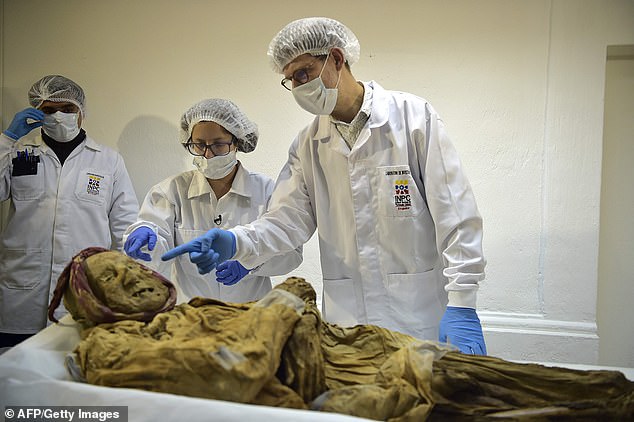A mummy dating back to the 16th century which was discovered in Ecuador in 1949 is now being examined by French pathologist Philippe Charlier.
Experts say that the relatively well-preserved cardboard-like figure could hold clues to the history of diseases as his bones contain traces of rheumatoid arthritis.
Dr Charlier, who has studied the remains of Hitler, Descartes, Robespierre, is studying the mummy, said to be a friar, discovered in the town of Guano, Ecuador.

A mummy dating back to the 16th century which was discovered after an earthquake in Ecuador in 1949 is now being examined by French pathologist Philippe Charlier. Experts say that the relatively well-preserved cardboard-like figure could hold clues to the history of diseases as his bones contain traces of rheumatoid arthritis
It was discovered in a ‘jar’ between the walls of a convent in a horizontal position next to a mummified rat, according to reports.
Jar burials are human burials where the corpse is placed into a large earthenware, or pot, and then buried.
The mᴀssive earthquake, which happened in August 1949, caused the walls of the old church Asunsion de Guano, to fall revealing the final resting place of the mysterious ancient being.
As the body was placed within a wall with a cold, dry environment, it was protected from flies and larvae so the tissues which bear the marks of the rheumatoid polyarthritis are well-preserved.
‘This is an extremely important mummy for the history of diseases,’ said forensic pathologist, anthropologist and paleontologist Philippe Charlier.
This inflammatory disease traces found in the monk’s joints, specific to the American continent, interested Dr. Charlier.

Dr Charlier, who has studied the remains of Hitler, Descartes, Robespierre, is studying the mummy, said to be a friar, discovered in the town of Guano, Ecuador. It was discovered between the walls of a convent in a horizontal position jnext to a mummified rat, according to reports

As the body was placed in a wall with a cold, dry environment, it was protected from flies and larvae so the tissues which bear the marks of the rheumatoid polyarthritis are well-preserved
‘It is a common disease now, but its home is in America, before the arrival of Christopher Columbus,’ he said.
‘The mummy of Guano may be the link missing that will allow us to understand how this disease, which was originally American, then became a global disease by hybridization, by the confrontation between two worlds.’
An earthquake in the Andean center of Ecuador in 1949 revealed the unusual burial spot of the man, believed to be a monk and guardian of the convent from 1560 to 1565.

An earthquake in the Andean center of Ecuador in 1949 revealed the strange burial of the supposed Franciscan monk and guardian of the convent from 1560 to 1565, according to the San Francisco University of Quito, which participates in the research

Research has not yet determined the date of death, but has determined its most likely cause: a chin fistula that has degenerated into abscess, sepsis or encephalitis. It also remains to confirm the idenтιтy of the mummy by studying the records of the Franciscan order
‘Guano’s mummy comes within the framework of atypical mummies, deaths and burials’ because of the position in which it was discovered and because of the absence of Christian elements such as a rosary beads and a coffin.’
Research has not yet determined the date of the man’s death, but they have determined the most likely cause: a chin fistula that turned into an abscess or sepsis.
It also remains to confirm the idenтιтy of the mummy by studying the records of the Franciscan order.
Carbon dating techniques, radiographs, and endoscopies helped scientists conclud that the mummy was 85 to 90 years old, according to reports.
The same report says that is tied around the mummy’s chin was found with him along with the mummified mouse; it is not clear why the mouse was buried with him.

Dr Charlier studied the mummy for two days. He took samples of bone and dry tissue for genetic analysis and carbon 14, or radiocarbon which would provide more indications to the genesis of the disease
Dr Charlier studied the mummy for two days. For his transfer from Guano to the radiocarbon lab in Quito, the technicians had to take the mummy in custom-made sponge coffin.
He took samples of bone and dry tissue for genetic analysis and carbon 14, or radiocarbon which would provide more indications to the genesis of the disease.
‘I do not work on the ᴅᴇᴀᴅ because death interests me, I work on the ᴅᴇᴀᴅ because they have a lot to tell us,’ he said.





